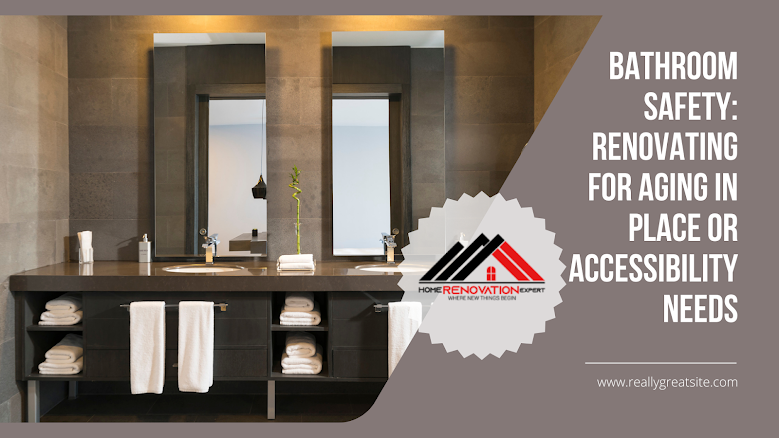Bathroom Renovation for a Family-Friendly Home: Tips for Creating a Functional Space
Bathroom Renovation for a Family-Friendly Home: Tips for Creating a Functional Space
Bathroom renovation is a popular home improvement project that can increase the value, comfort, and functionality of your house. However, renovating a bathroom for a family-friendly home can be challenging, as you need to consider the needs and preferences of different family members, especially children. How can you create a bathroom that is safe, practical, and stylish for everyone? Here are some tips to help you plan and execute a successful bathroom renovation for a family-friendly home.
Plan Ahead and Set a Budget
The first step in any bathroom renovation project is to plan ahead and set a budget. You need to decide what you want to achieve with your renovation, what features and fixtures you want to include, and how much you are willing to spend. Planning ahead will help you avoid costly mistakes and delays, as well as ensure that your renovation meets your expectations and needs.
Some of the things you need to consider when planning your bathroom renovation are:
The size and layout of your bathroom. Do you have enough space for everything you want? Do you need to knock down or add walls, move plumbing or electrical lines, or change the door or window placement?
The style and design of your bathroom. What kind of look and feel do you want for your bathroom? Do you want a modern, minimalist, rustic, or traditional style? What colors, materials, and finishes do you prefer? How do you want to balance aesthetics and functionality?
The features and fixtures of your bathroom. What kind of bathtub, shower, sink, toilet, vanity, faucet, lighting, storage, and accessories do you want for your bathroom? How do they fit with your style and design choices? How do they meet the needs and preferences of different family members?
The budget and timeline of your bathroom renovation. How much money do you have to spend on your bathroom renovation? How long do you expect the renovation to take? Do you have a contingency fund for unexpected expenses or delays? Do you need to hire professionals or do some work yourself?
Pick Reputable Tradespeople
The next step in your bathroom renovation project is to pick reputable tradespeople who can help you execute your plan. Unless you are very skilled and experienced in DIY projects, it is advisable to hire professionals who can handle the plumbing, electrical, carpentry, tiling, painting, and other aspects of your renovation. Hiring reputable tradespeople will ensure that your renovation is done properly, safely, and efficiently.
Some of the things you need to consider when picking tradespeople are:
Their qualifications and credentials. Do they have the necessary licenses, certifications, insurance, and warranties to perform the work? Do they have references or reviews from previous clients that you can check?
Their experience and expertise. Do they have the skills and knowledge to handle the type of work you need? Do they have examples or portfolios of their previous work that you can see?
Their availability and communication. Do they have the time and resources to complete your project within your desired timeline? Do they communicate clearly and promptly with you throughout the project?
Their price and contract. Do they offer a reasonable and transparent quote for their services? Do they provide a written contract that outlines the scope, cost, schedule, and terms of their work?
Build Niches and Recesses for Extra Room
One of the challenges of renovating a bathroom for a family-friendly home is creating enough room for everyone’s belongings and needs. A clever way to maximize space in your bathroom is to build niches and recesses into the walls or floors. Niches and recesses are small indentations or openings that can be used to store or display items such as shampoo bottles, soap bars, towels, candles, plants, etc. They can also add visual interest and style to your bathroom.
Some of the benefits of building niches and recesses in your bathroom are:
They save space by eliminating the need for shelves, cabinets, or baskets that take up floor or counter space.
They keep items organized and accessible by providing designated spots for different categories or users.
They prevent clutter by reducing the number of items that are left on the floor or counter.
They enhance safety by minimizing the risk of slipping or tripping over items that are on the floor or counter.
They improve hygiene by allowing items to dry faster and preventing mold or mildew growth.
Some of the places where you can build niches and recesses in your bathroom are:
In the shower or bathtub wall. You can build niches at different heights and sizes to accommodate different types of products or users. For example, you can build a niche at eye level for adults’ shampoo bottles, a niche at chest level for kids’ toys, and a niche at foot level for razors or sponges.
In the vanity wall. You can build recesses behind or above the sink to store toothbrushes, toothpaste, makeup brushes, cotton pads, etc. You can also build recesses on either side of the mirror to display decorative items or plants.
In the toilet wall. You can build niches above or beside the toilet to store toilet paper, magazines, air fresheners, etc. You can also build a niche behind the toilet to hide the plumbing or electrical wires.
In the floor. You can build recesses in the floor to create a step or a platform for the bathtub, shower, or sink. This can add height and dimension to your bathroom, as well as provide extra storage space underneath.
Choose Simple and Straightforward Finishes
Another challenge of renovating a bathroom for a family-friendly home is choosing finishes that are durable, easy to clean, and appealing to everyone. A simple and straightforward way to achieve this is to choose finishes that are neutral, natural, and timeless. These finishes can create a clean and cozy atmosphere in your bathroom, as well as match with any style or design you prefer.
Some of the finishes you can choose for your bathroom are:
Ceramic or porcelain tile. Tile is a classic and versatile finish that can be used for the floor, walls, or backsplash of your bathroom. Tile is durable, water-resistant, stain-resistant, and easy to clean. Tile also comes in a variety of colors, shapes, sizes, and patterns that can suit any taste or preference.
Stone or quartz. Stone or quartz is a luxurious and elegant finish that can be used for the countertop, sink, or bathtub of your bathroom. Stone or quartz is strong, scratch-resistant, heat-resistant, and easy to maintain. Stone or quartz also has a natural and organic look that can add warmth and texture to your bathroom.
Wood or laminate. Wood or laminate is a cozy and inviting finish that can be used for the vanity, shelves, or accessories of your bathroom. Wood or laminate is affordable, lightweight, and easy to install. Wood or laminate also has a rustic and charming look that can add character and personality to your bathroom.
Conclusion
Renovating a bathroom for a family-friendly home can be a rewarding and enjoyable project that can improve the quality of life for everyone in your household. By following these tips, you can create a bathroom that is safe, practical, and stylish for everyone. Happy renovating! 😊


Comments
Post a Comment